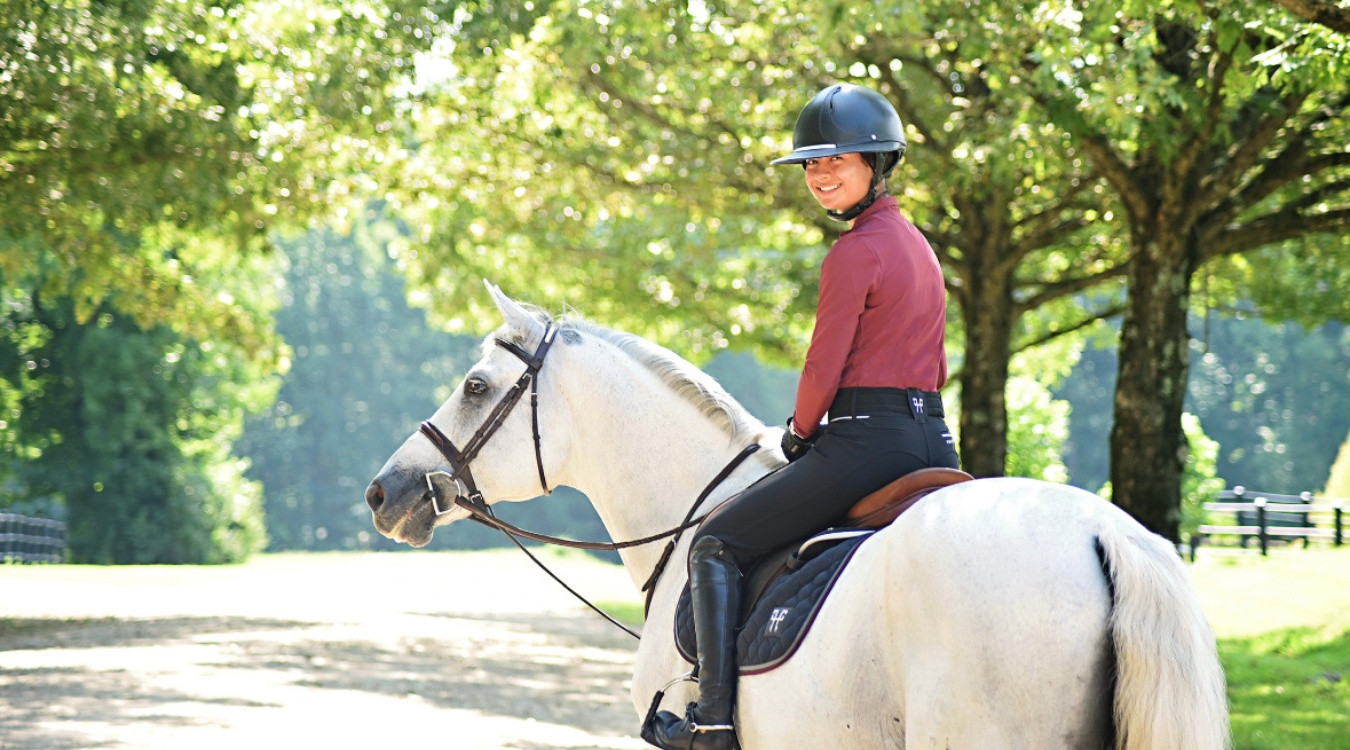
Hunter, a discipline of American equestrian heritage, is now booming in Europe. This discipline, which consists in completing an obstacle course in harmony with one’s horse, was originally designed to keep hunter riders busy outside the hunting season. This explains the quest for elegance in the horse’s presentation and the rider’s attire, the precision of the course, and the different obstacle profiles.
Now open to all, Hunter events enable young riders to build a solid foundation in horsemanship.
Madison Keese, an American rider, reveals the secrets of this discipline, which combines technique and rigor. From its specificities and origins to its regulations, in this interview Madison explains how to perform, while respecting the traditional codes of this historic discipline.
Hunter, a precision sport
Madison defines hunter riding as riding as efficiently as possible to reveal the horse’s potential and availability on the course. As she explains, it’s a traditional discipline, based on classic codes, whose main objective is to ride as cleanly and evenly as possible.
Horses must therefore be particularly well trained to make them available and responsive to the aids used. Precise, rigorous work of the horse on the flat is one of the fundamentals of hunter riding, while the height of the obstacles is a secondary consideration in this discipline.
Madison explains that riders need to be as precise as possible in managing the distances between obstacles, as well as in the approach and landing phase.
Hunter riding takes us back to the origins and fundamentals of equestrianism, with respect for tradition. These traditions are reflected not only on the track, but also in the way the rider dresses and prepares the horse.
Hunter in United States, a national discipline
In the United States, Hunter riding is like a ritual for young American riders. So it was only natural that Madison began her riding career with Hunter.
She explains that, in the United States, if you want to ride, most of the time you have to start with Hunter and then choose your discipline. Riders often move on to show jumping.
Hunter riding is particularly well developed in the United States, as it introduces the basics of show jumping. Unlike in the rest of the world, American riders are obliged to do two seasons of Hunter before they can compete in show jumping! Hunter is therefore a discipline in its own right in the United States’ equestrian heritage.
This discipline, long associated with the United States, has gradually made its way to Europe, and for many years now has been a flagship discipline in equestrianism. Indeed, coaches and trainers see this discipline as a way of training riders to ride calmly and rigorously, and this is what has contributed greatly to its development.

Showcasing horse and rider
Madison takes a look back at her beginnings as a horsewoman and Hunter rider. She explains that she chose Hunter because she really likes the feeling of bringing out the best in the horse. Beyond performance, she focuses on gaits, regularity and presentation. She also looks for finesse and precision in her jumps, and enjoys the feeling that her horse is jumping well. It’s not just about jumping high that drives her to work, but above all about achieving a harmonious course.
As for the rider, Madison explains that Hunter allows you to learn to control your body, your position and the use of your aids. This discipline requires you to be able to control your horse perfectly and be as efficient as possible, while remaining discreet. It also highlights the amount of work required with your horse to achieve the goals imposed by Hunter competition.
Choosing and working your horse
To practice Hunter, Madison explains that the horse must be willing and in good physical condition. He must have a good jump, articulate movements and good legs. His cadence should be naturally good, his gait should be regular and he should be particularly calm.
During training sessions, Madison’s main focus is on having a horse that responds perfectly to aids, with rigor and straightness. Hunter riders work as much on dressage as on show jumping, but focus more on the horse’s attitude and availability.
Hunter : a sober, chic and elegant sport
Riders wear classic, elegant, sober outfits in timeless, dark colors such as black, gray or navy blue. Only the pants are allowed to be light in color, usually beige. Unlike show jumping and dressage riders, Hunter riders don’t wear white pants.
The horse must also be groomed, in the same way as in dressage competitions. It must be perfectly shorn, brushed and groomed, and must have its mane, mane and tail braided.
During competitions, riders must respect a specific, sober and clean outfit. Instead of the classic white competition pants, they must wear sober-colored pants, mostly in beige. Added to this is a vest, a shirt, a rider tie for men, a fishnet to hold long hair, a helmet,boots and dark gloves.
When it comes to horses, certain equipment must also comply with certain rules. The rug must follow the shape of the saddle, to emphasize the horse’s movement. The rest of the accessories have no particular regulations, not even for the mouthpiece or tack.
Horses must also be perfectly clean, with their coats clipped, manes, tails and tufts brushed and plaited. Their presentation is similar to that of a dressage test.
For both horse and rider, all accessories must be clean and tidy.
These requirements for horse and rider help to create uniqueness and harmony in the pair, and follow the traditional codes taught on the track by Hunter.

Hunter competitions
Several types of Hunter courses are available
There are different types of Hunter courses and events. Riders can choose to compete in Hunter Style, Hunter Equitation or Hunter Derby.
Hunter Style judges the horse’s movement, jumping, dressage and general attitude. He must have a beautiful neck, a small head and good legs. This test is graded on 20 points.
Hunter Equitation judges the rider’s horsemanship and harmony with the horse, including balance, riding position and use of aids. To highlight the rider’s horsemanship, the horse must be calm and stable. This test is marked out of 100 points.
A third type of event is the Hunter Derby. These are Madison’s favorite events, as the courses are similar to show jumping, but more technical, with bigger obstacles and the possibility of going faster.
These events were created to counter the decline of Hunter in the United States in the early 2000s.
A typical Hunter contest
As a regular competitor, Madison takes us through a weekend of Hunter competition. Arriving the day before she’s due to compete, she follows the classic process of a show jumping competition, carrying out the veterinary visit, as well as the warm-up: a session during which riders can come onto the show ring to jump a few obstacles.
In the Hunter Style test, she performs a presentation of her horse, in which the horse’s movement, expressions and attitude are noted. The judges decide which horse moves best and award a score to each.
She then takes part in the Hunter Equitation event. Once the competition gets underway, she explains that the riders will reconnoiter the course at the designated time. The reconnaissance period is longer, as they have to recognize the layout, the compulsory passages, the transitions and discover the stride contracts. Before the start of the course, the rider must indicate which stride contracts he will respect, depending on his horse. Courses can be made up of 8 to 14 obstacles, depending on the level of the event. There are no red and white flags on the stanchions in Hunter.
Once on the track, the rider must wait for the bell to ring, then make a circle 20 meters in diameter to indicate the start. Throughout the course, the horse’s canter must be steady, the approach controlled, and each fault costs points on the final score. Riders can earn up to 100 points. These points are earned on the basis of stride contracts, layout, cadence and the attitude of horse and rider.
Some elements are worth the same number of points as others. This is the case for stride contracts, which are scored out of 40. If the course comprises 8 contracts, then each contract is worth 5 points. If there is a fault on an obstacle in this contract, the penalty is also 5 points. Finally, refusals are worth 10 penalty points.
The other elements taken into account are judged by the judges and vary according to each couple.
The round ends with a second 20-meter circle.

The Hunter ranking system
The event is ranked from highest to lowest. The prize-giving ceremony can be held on foot or on horseback at the end of the test. As with dressage events, the rider receives a score sheet on which the various scores obtained are indicated, along with comments.
Riders earn points as they progress through the various stages, in their bid to be selected for the national championships.
International Hunter
The expansion of Hunter riding throughout the world, and particularly in Europe, is a real asset for the sport and for the sport itself. This will give it more and more visibility, increase the number of members every year and also increase the number of competitions.
For Madison, this discipline has a lot of potential with riders and internationally, as it conveys strong values. Hunter deserves its place among international disciplines.
You can follow Madison’s journey on her instagram: @madisonkeese


